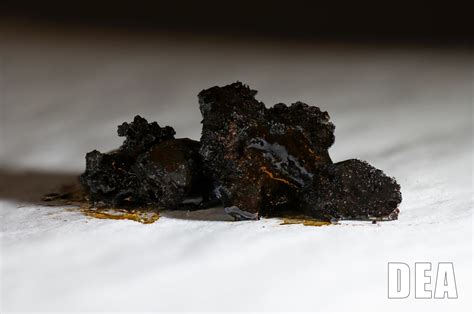The issue of black tar drugs, particularly heroin, has been a persistent and devastating problem in many communities worldwide. This form of heroin, known for its dark, tar-like appearance, is often less pure than its white or brown powdered counterparts but can be just as dangerous and addictive. The origins, distribution, and impact of black tar heroin are complex, weaving a tragic narrative of addiction, crime, and public health crises.
Origins and Distribution
Black tar heroin is primarily produced in Mexico, where it is often synthesized from morphine, a natural substance found in the opium poppy plant. The process of creating black tar heroin involves acetylation, a chemical reaction that converts morphine into heroin. However, the methods used by Mexican cartels and other producers can result in a less refined product, which may contain more impurities and have a distinct black color. This version of heroin is cheaper to produce and can be more accessible to users, contributing to its widespread availability in the U.S., particularly in the western and midwestern regions.
The distribution of black tar heroin is often linked to organized crime, with cartels controlling much of the supply chain. The drug is typically smuggled across the U.S.-Mexico border, where it is then disseminated through a network of dealers to cities and towns across the country. The profitability of heroin, coupled with its high demand due to the opioid epidemic, has made it a lucrative business for criminal organizations.
Health Risks and Addiction
The health risks associated with black tar heroin are numerous and severe. Users often inject, smoke, or snort the drug, practices that come with significant risks, including overdose, infection, and the transmission of blood-borne diseases like HIV and hepatitis. The adulterants and impurities in black tar heroin can also lead to unexpected reactions or increased risk of overdose, as the user may not know the exact composition or potency of the drug.
Addiction to heroin is a powerful and often intractable condition. Heroin binds to opioid receptors in the brain, producing a rush of euphoria, but it also leads to tolerance and dependence. Users may find themselves needing to take larger doses to achieve the desired effect, placing them at a higher risk of overdose. Withdrawal symptoms can be agonizing, further complicating efforts to cease use.
Public Health Response
Addressing the issue of black tar heroin and opioid addiction more broadly requires a comprehensive public health approach. This includes increasing access to evidence-based treatment programs, such as medication-assisted therapy (MAT), which combines medications like methadone or buprenorphine with counseling and behavioral therapy. Naloxone distribution programs, which provide access to a drug that can reverse opioid overdoses, have also been critical in saving lives.
Prevention efforts are equally important, focusing on educating the public about the risks of heroin and opioid use, as well as addressing the root causes of addiction, such as mental health issues, trauma, and lack of economic opportunities. Reducing the stigma associated with drug addiction and encouraging individuals to seek help without fear of judgment or legal repercussions are crucial steps towards mitigating the heroin epidemic.
Legal and Policy Initiatives
Law enforcement and policy efforts are also essential components of the response to black tar heroin. This includes strengthening border security to reduce smuggling, dismantling drug trafficking organizations, and implementing policies that address the overprescription of opioid painkillers, which can lead to heroin use when prescriptions become too expensive or difficult to obtain.
However, there is also a growing recognition of the need for drug policy reform, with some advocating for the decriminalization of drug possession for personal use and increased investment in harm reduction services. The goal of such initiatives is to treat drug addiction as a public health issue rather than a criminal justice problem, potentially reducing the number of people incarcerated for non-violent drug offenses and directing resources towards treatment and recovery.
Future Directions
The future of the fight against black tar heroin and opioid addiction involves a complex interplay of public health initiatives, law enforcement strategies, and policy changes. As understanding of addiction evolves, so too must the approaches to addressing it. This includes investing in research on addiction, improving accessibility and affordability of treatment, and fostering community engagement and support for those affected by drug use.
Moreover, addressing the social determinants of health—such as poverty, lack of education, and unemployment—that contribute to drug addiction is critical. This requires a coordinated effort across different sectors, from healthcare and law enforcement to education and economic development, to create environments where individuals have the support and opportunities needed to avoid or recover from addiction.
What are the primary health risks associated with black tar heroin use?
+The primary health risks include overdose, infection, transmission of blood-borne diseases like HIV and hepatitis, and unexpected reactions due to the drug's variable composition and potency.
How is black tar heroin typically distributed in the U.S.?
+It is primarily smuggled across the U.S.-Mexico border and then distributed through a network of dealers controlled by organized crime groups, particularly Mexican cartels.
What are some key components of an effective public health response to the black tar heroin epidemic?
+This includes increasing access to medication-assisted treatment (MAT) and counseling, distributing naloxone for overdose reversal, prevention and education programs, and policy initiatives to reduce stigma and increase support for those addicted.
How can addressing social determinants of health help in combating drug addiction?
+Addressing factors such as poverty, lack of education, and unemployment can reduce the vulnerability of individuals to drug addiction by providing them with stable environments, economic opportunities, and access to healthcare and social services.
What role does public perception and stigma play in the response to the heroin epidemic?
+Public perception and stigma can significantly impact whether individuals seek help for addiction. Reducing stigma and promoting a compassionate understanding of addiction as a disease rather than a moral failing can encourage more people to seek treatment and support recovery efforts.
Ultimately, the struggle against black tar heroin and opioid addiction is multifaceted, requiring a concerted effort from various stakeholders. By combining effective treatment options, public health initiatives, legal and policy reforms, and a shift in societal attitudes, it’s possible to mitigate the devastating impact of heroin use and work towards a future where addiction is treated with compassion and understanding, rather than fear and rejection.


